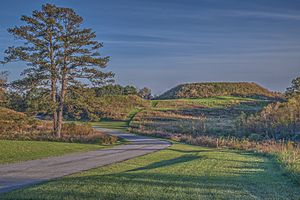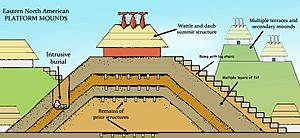Platform mound facts for kids
A platform mound is a special type of hill or raised area made by people. It's built to hold buildings or activities on its flat top. Imagine a pyramid with its top cut off – that's often what a platform mound looks like!
Contents
Platform Mounds in North America

Native American people in North America built these mounds for over a thousand years. They started building them in the Archaic period and continued through the Woodland period. Many ancient cultures in the eastern parts of North America used platform mounds. These included the Poverty Point culture, Troyville culture, Coles Creek culture, Plaquemine culture, and Mississippian culture.
What They Looked Like
These mounds were usually shaped like pyramids with flat tops. They had steep sides and often featured steps made of wooden logs. When Europeans first arrived, the Mississippian people were still using and building these mounds.
What They Were Used For
Platform mounds had many uses for the Mississippian culture. They were used as bases for important buildings, like:
- Houses for tribal leaders or chiefs.
- Public temples for religious ceremonies.
- Places for preparing bodies for burial (mortuary platforms).
- Buildings where bones were kept (charnel houses).
- Large meeting houses or town halls.
- Homes for important people.
- Areas for special dances or gatherings.
How Mounds Were Built
Many mounds grew larger over time. They were built in several stages. A special spot, perhaps a burial ground or a civic building, was chosen. Then, workers would carry soil and clay in baskets to cover the site. This created a new layer, and a new building would be placed on top.
Every twenty years or so, the old building might be removed. This could be part of a special ceremony. Then, more soil was added, making the mound even taller. A new building would then be built on the higher top. Sometimes, the mounds were covered with brightly colored clay. Builders also used different types of clay and soil to make sure the steep sides wouldn't collapse.
All the soil needed for these mounds came from somewhere. This left large holes in the ground called "borrow pits." Sometimes, these pits filled with water and became ponds where fish lived.
Mounds with Levels
Some mounds had different levels or terraces. For example, Emerald Mound has one large terrace with two smaller mounds on its top. Monks Mound, which is almost 100 feet (30 meters) tall, has four separate levels. Monks Mound was built over 200 years, with at least ten different building periods. Some terraces were added to help keep the huge mound from sliding down.
Burials in Mounds
Even though mounds were mainly for buildings, sometimes people were buried inside them. This happened when a grave was dug into the mound, and a body or bones were placed there. Mound C at Etowah had over 100 burials in its top layer. These burials included many valuable items, such as copper plates, stone axes, special pottery, and carved shell necklaces. Two white marble statues were also buried in this mound.
Platform Mounds Around the World
Platform mounds were not just built in North America. They were also used by other ancient cultures, including:
- The Olmec and other groups in Mesoamerica (Central America and Mexico). You can learn more about them by looking up Mesoamerican pyramids.
- The Norte Chico people in Peru.
- The Hohokam people in the southwestern United States.
- People in Ancient China. See Chinese pyramids for more information.
See also
 In Spanish: Montículo de plataforma para niños
In Spanish: Montículo de plataforma para niños
Images for kids
-
The Kincaid Mounds State Historic Site in Illinois, showing platform mounds.



